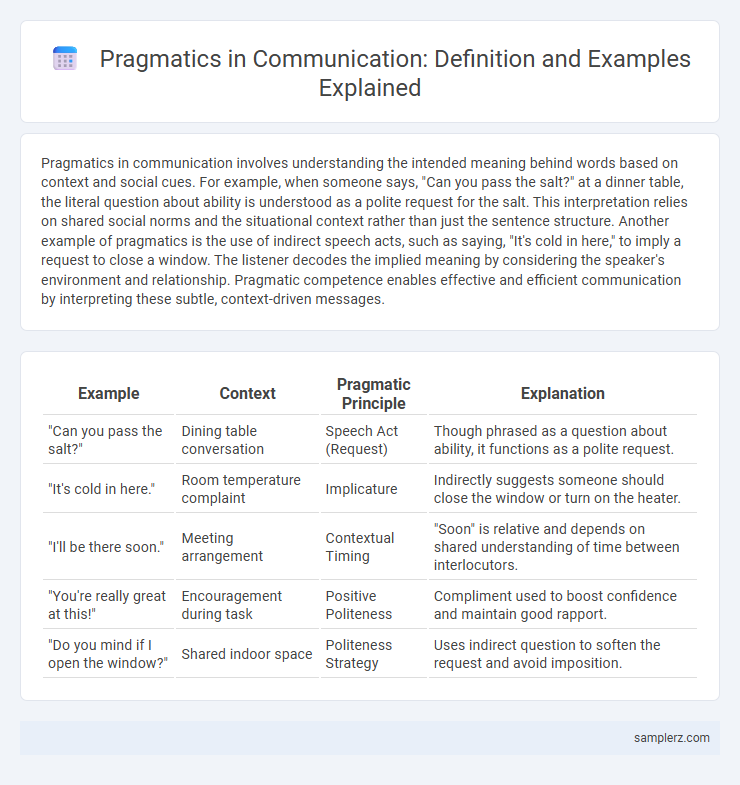Pragmatics in communication involves understanding the intended meaning behind words based on context and social cues. For example, when someone says, "Can you pass the salt?" at a dinner table, the literal question about ability is understood as a polite request for the salt. This interpretation relies on shared social norms and the situational context rather than just the sentence structure. Another example of pragmatics is the use of indirect speech acts, such as saying, "It's cold in here," to imply a request to close a window. The listener decodes the implied meaning by considering the speaker's environment and relationship. Pragmatic competence enables effective and efficient communication by interpreting these subtle, context-driven messages.
Table of Comparison
| Example | Context | Pragmatic Principle | Explanation |
|---|---|---|---|
| "Can you pass the salt?" | Dining table conversation | Speech Act (Request) | Though phrased as a question about ability, it functions as a polite request. |
| "It's cold in here." | Room temperature complaint | Implicature | Indirectly suggests someone should close the window or turn on the heater. |
| "I'll be there soon." | Meeting arrangement | Contextual Timing | "Soon" is relative and depends on shared understanding of time between interlocutors. |
| "You're really great at this!" | Encouragement during task | Positive Politeness | Compliment used to boost confidence and maintain good rapport. |
| "Do you mind if I open the window?" | Shared indoor space | Politeness Strategy | Uses indirect question to soften the request and avoid imposition. |
Introduction to Pragmatics in Communication
Pragmatics in communication studies how context influences the interpretation of meaning beyond the literal words spoken, including how speakers imply intentions and listeners infer them. For example, when someone says, "Can you pass the salt?" the pragmatic understanding is that it functions as a polite request rather than a question about ability. This aspect highlights how social cues, shared knowledge, and situational factors shape effective and nuanced human interactions.
The Role of Context in Pragmatic Meaning
Context shapes the pragmatic meaning of communication by influencing how utterances are interpreted beyond their literal sense. For example, the phrase "Can you pass the salt?" is understood as a polite request rather than a question about ability, depending on situational cues and shared knowledge between speaker and listener. Pragmatics relies heavily on contextual factors such as speaker intention, social relationships, and environmental settings to convey implied meanings effectively.
Deixis: Understanding References in Conversation
Deixis in communication involves interpreting words like "this," "that," "here," and "there," which rely on contextual information to convey meaning accurately. For example, when a speaker says, "Put that there," the listener must use situational cues to identify the specific objects and locations referenced. Understanding deixis enhances effective communication by grounding abstract language in the immediate physical or conversational context.
Speech Acts: How We Do Things with Words
Speech acts exemplify pragmatics by illustrating how utterances perform actions beyond conveying information, such as promising, requesting, or apologizing. John Searle's classification divides speech acts into representatives, directives, commissives, expressives, and declarations, each serving distinct communicative functions. These acts depend on context and speaker intention, highlighting the dynamic interplay between language and social interaction in effective communication.
Implicature: Communicating Beyond the Literal
Implicature in communication involves conveying meanings that go beyond the literal interpretation of words, allowing speakers to imply additional information without explicitly stating it. For example, when someone says "It's cold in here," the implicature might be a request to close a window rather than a mere observation about temperature. This pragmatic strategy relies on shared context and conversational maxims, enabling effective and nuanced interactions.
Politeness Strategies in Everyday Interaction
Politeness strategies in everyday communication include the use of indirect requests, hedging, and honorifics to maintain social harmony and show respect. Speakers often employ positive politeness by expressing friendliness or solidarity, while negative politeness strategies emphasize minimizing imposition, such as using modal verbs like "could" or "would." These pragmatic tools help navigate social hierarchies and prevent face-threatening acts, ensuring effective and culturally sensitive interaction.
Presupposition and Shared Knowledge
Presupposition in communication occurs when speakers assume listeners already possess certain background information, such as saying "Jane's brother arrived," presuming the listener knows Jane has a brother. Shared knowledge enhances pragmatic understanding by enabling interlocutors to interpret meanings based on common experiences or cultural references, like using idioms understood within a community. Effective communication relies on these pragmatic elements to convey messages efficiently and avoid misunderstandings.
Irony and Sarcasm: Pragmatic Nuances
Irony in communication often relies on the speaker conveying a meaning opposite to the literal words, requiring the listener to interpret context and tone for accurate understanding. Sarcasm, a form of verbal irony, uses exaggerated or mocking expressions to convey contempt or humor, depending on pragmatic cues such as intonation, facial expressions, and situational context. Effective interpretation of irony and sarcasm demonstrates advanced pragmatic competence, highlighting the importance of shared knowledge and social dynamics in conversational exchanges.
Pragmatic Failures and Miscommunication
Pragmatic failures in communication occur when speakers misinterpret or ignore the implied meaning, leading to misunderstandings despite correct grammar and vocabulary. For example, a request phrased as a question like "Can you pass the salt?" may be taken literally, causing confusion if the listener focuses on the ability rather than the intended action. Miscommunication often arises from contextual differences, cultural norms, or assumptions about shared knowledge that affect how indirect speech acts are perceived and responded to.
Cultural Variations in Pragmatic Use
Cultural variations in pragmatic use manifest in how indirect requests are interpreted across different societies, where politeness strategies differ significantly. For instance, in East Asian cultures, indirect speech acts such as implied refusals or requests are common to maintain harmony, while in Western cultures, directness is often preferred for clarity and efficiency. Understanding these cultural pragmatic differences is essential for effective cross-cultural communication and avoiding misinterpretations.

example of pragmatics in communication Infographic
 samplerz.com
samplerz.com